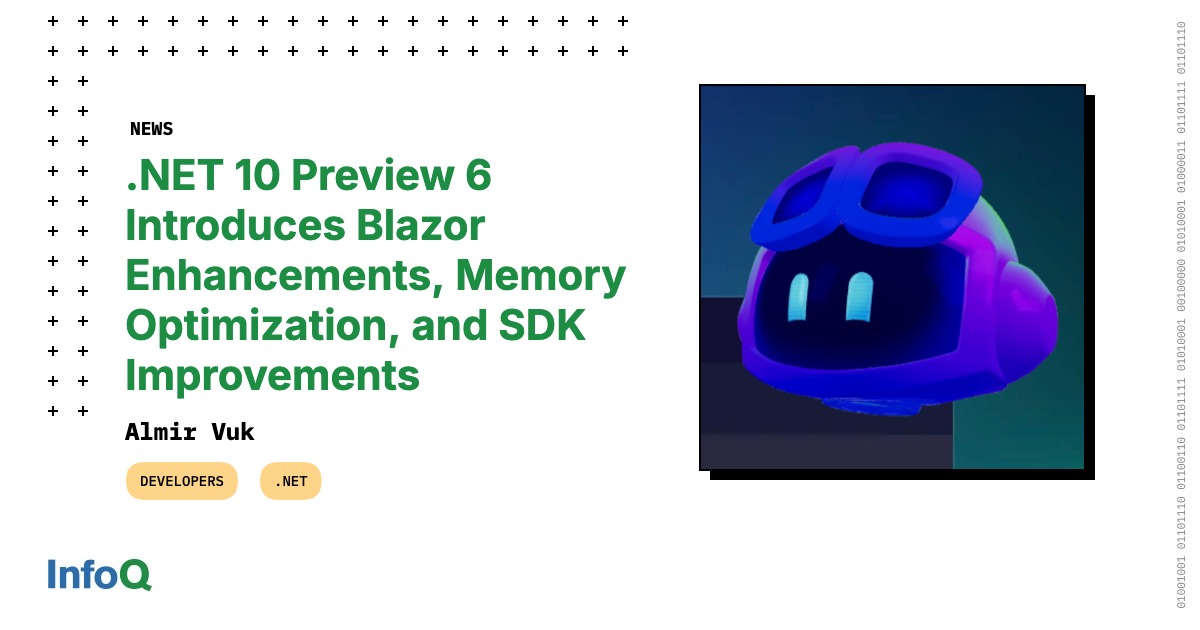Microsoft has announced the sixth preview of .NET 10, introducing a broad range of enhancements across the .NET Runtime, SDK, libraries, C#, ASP.NET Core, Blazor, and .NET MAUI. As stated in the official release, the update focuses on improving performance, developer experience, and cross-platform tooling.
In the realm of ASP.NET Core, memory management has been refined. Kestrel, IIS, and HTTP.sys now supports automatic eviction of unused memory from its internal pools when applications are idle. As reported, this change requires no developer action and is designed to reduce memory usage efficiently. Metrics for memory pools are now exposed under Microsoft.AspNetCore.MemoryPool, and developers can build custom memory pools using the new IMemoryPoolFactory interface.
Blazor also receives several key updates. A new <LinkPreload /> component offers more control over preloading framework assets, improving performance and base URL detection. Blazor WebAssembly projects can now generate output compatible with JavaScript bundlers like webpack by setting WasmBundlerFriendlyBootConfig to true, allowing, as stated, better integration with modern frontend pipelines.
Validation support in Blazor has been extended to include nested objects and collections within forms. This new capability is enabled through AddValidation() and the [ValidatableType] attribute. With a note that the attribute remains experimental and requires diagnostic suppression. Blazor diagnostics were improved as well, with traces for server circuits now exposed as top-level activities, simplifying telemetry in tools like Application Insights.
Blazor Server now supports persisting circuit state, allowing users to resume activity after reconnecting, even after server-side eviction. Developers can control circuit behavior through the new Blazor.pause() and Blazor.resume() APIs, as explained this will help reduce server resource consumption during idle periods.
Navigation behavior in Blazor was updated for consistency, with a configuration switch now opt-in to disable NavigationException usage. ASP.NET Core Identity now includes support for passkeys, enabling modern, phishing-resistant authentication using the WebAuthn and FIDO2 standards. The Blazor Web App template includes built-in support for this.
Minimal APIs can now integrate validation error responses using IProblemDetailsService, offering more consistent and customizable error output. As reported, the validation APIs have moved to a new Microsoft.Extensions.Validation package and namespace, broadening their usage beyond ASP.NET Core.
Regarding the .NET MAUI, the MediaPicker component was enhanced to support multiple file selection and in-API image compression. Developers can also now intercept web requests within BlazorWebView and HybridWebView, enabling advanced scenarios like modifying headers or injecting custom responses.
Furthermore, various UI fixes were implemented across controls, including CollectionView, CarouselView, and SearchBar, along with memory leak resolutions and improved rendering on Windows, Android, and iOS. Additionally, .NET now supports Android API levels 35 and 36, and includes diagnostics and interop performance improvements. On Apple platforms, the release aligns with Xcode 16.4 and brings reliability and runtime enhancements.
The .NET SDK introduces major improvements for tool authors, including support for platform-specific tools within a single package, and the new dotnet tool exec command, which, as described in the official docs, allows one-shot execution without installation. Also the lightweight dnx script further simplifies tool execution.
CLI introspection capabilities were extended with the –cli-schema option, which outputs a machine-readable JSON representation of commands, aiding automation and scripting. File-based apps received additional improvements, including support for native AOT publishing, project references, and enhanced shebang support for shell execution.
For interested readers, full release notes and further technical documentation are available on the official .NET documentation, also the developers can join the GitHub discussion.



3.png-e1695200541979.png)





